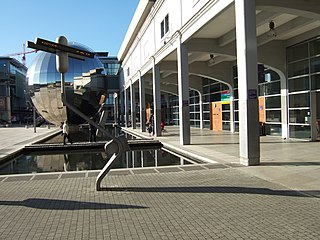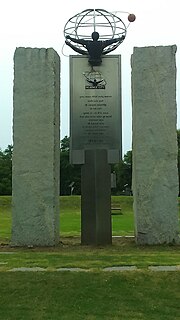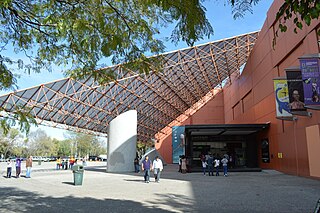
Bas-Rhin is a department in Alsace which is a part of the Grand Est super-region of France. The name means 'Lower Rhine', referring to its lower altitude among both French Rhine departments: it is downstream of the Haut-Rhin department. Note that both belong to the European Upper Rhine region. It is, with the Haut-Rhin, one of the two departments of the traditional Alsace region. The more populous and densely populated of the pair, it had 1,140,057 inhabitants in 2019. The prefecture is based in Strasbourg. The INSEE and Post Code is 67.

The Canadian Museum of Nature is a national natural history museum based in Canada's National Capital Region. The museum's exhibitions and public programs are housed in the Victoria Memorial Museum Building, a 18,910 square metres (203,500 sq ft) structure in Ottawa, Ontario. The museum's administrative offices and scientific centres are housed at a separate location, the Natural Heritage Campus, in Gatineau, Quebec.

The Buffalo Museum of Science is a science museum located at Martin Luther King Jr. Park in Buffalo, New York, United States, northeast of the downtown district, near the Kensington Expressway. The historic building was designed by August Esenwein and James A. Johnson and opened on January 19, 1929. The attractions include exhibits showcasing animals, astronomy, the science of technology, and additional science topics.

We The Curious is a science and arts centre and educational charity in Bristol, England. It features over 250 interactive exhibits over two floors, and members of the public and school groups can also engage with the Live Science Team over programming in the kitchen, studio and on live lab. We The Curious is also home of the United Kingdom's first 3D planetarium. The centre describes its aim as being "to create a culture of curiosity".

The Museum of Science (MoS) is a science museum and indoor zoo in Boston, Massachusetts, located in Science Park, a plot of land spanning the Charles River. Along with over 700 interactive exhibits, the museum features a number of live presentations throughout the building every day, along with shows at the Charles Hayden Planetarium and the Mugar Omni Theater, the only domed IMAX screen in New England. The museum is also an accredited member of the Association of Zoos and Aquariums (AZA) and is home to over 100 animals, many of which have been rescued and rehabilitated.

The Natural History Museum Vienna is a large natural history museum located in Vienna, Austria. It is one of the most important natural history museums worldwide.

COSI, officially the Center of Science and Industry, is a science museum and research center in Columbus, Ohio. Originally, COSI was opened to the public on 29 March 1964 and remained there for 35 years. In 1999, COSI was moved to a 320,000-square-foot (30,000 m2) facility designed by Japanese architect Arata Isozaki along a bend in the Scioto River in the Franklinton neighborhood. COSI features more than 300 interactive exhibits throughout themed exhibition areas.

Shanghai Science and Technology Museum is a large museum in Pudong, Shanghai, close to Century Park, the largest park within the inner districts of the city. It is one of China's most-visited museums. It received 1,351,000 visitors in 2020, despite a fall of attendance of 72 percent from 2019 due to restrictions and reduced tourism imposed by the COVID-19 pandemic.

Eureka! The National Children's Museum is an interactive educational museum for children in Halifax, West Yorkshire, England, with a focus on learning through play. It is run as an educational charity and not-for-profit organisation. Eureka! is based on the North American model of children's museums, aimed at families with children aged 0–11 and encourages hands-on inter-generational learning.

The Royal Alberta Museum (RAM) is a museum of human and natural history in Edmonton, Alberta, Canada. The museum is located in Downtown Edmonton, north of City Hall. The museum is the largest in western Canada with more than 7,600 square metres (82,000 sq ft) exhibition space and 38,900 square metres (419,000 sq ft) in total.

Gujarat Science City is a science education and entertainment centre located in Ahmedabad, Gujarat, India. Opened in 2002, it has an IMAX 3D theatre; exhibitions on science, space, energy, life sciences, plants, nature and robotics; an aquarium, an aviary and a butterfly park; as well as other facilities.

Copernicus Science Centre is a science museum standing on the bank of the Vistula River in Warsaw, Poland. It contains over 450 interactive exhibits that enable visitors to single-handedly carry out experiments and discover the laws of science for themselves. The Centre is the largest institution of its type in Poland and one of the most advanced in Europe. In 2018, since its opening, it has been visited by over 8 million people.

The building of the European Court of Human Rights is located in the European Quarter of Strasbourg, France. It was designed by the Richard Rogers Partnership and Claude Buche and was completed in 1994.

CosmoCaixa Barcelona is a science museum located in Barcelona, Catalonia, Spain. Formerly known as the Science Museum of Barcelona, it closed for renovations in 1998 and reopened in 2004 under its current name. The museum features a variety of exhibitions, permanent and temporary, that showcase the environment, nature, science, and space. CosmoCaixa also has a planetarium and exhibitions devoted to interaction such as touch and play for small children. It also has a bookstore, gift shop, library, teaching center and cafe. The museum is sponsored by la Caixa. Entry to the museum is free for students under 16. Adults too can enjoy at the museum with an entry ticket of 6 euros.

Universum is Mexico's primary museum dedicated to promoting science and technology to the public as well as support the university's science missions. It was opened in 1992 at the Ciudad Universitaria in Mexico City. Today it has thirteen halls divided by theme dedicated to various permanent exhibitions. It has worked with outside public and private entities to develop both permanent and temporary exhibitions and has worked to develop other science museums in other areas of the country.

The AMNH Exhibitions Lab or AMNH Department of Exhibition is an interdisciplinary art and research team at the American Museum of Natural History that designs and produces museum installations, computer programs and film. Founded in 1869, the lab has since produced thousands of installations, many of which have become celebrated works. The department is notable for its integration of new scientific research into immersive art and multimedia presentations. In addition to the famous dioramas at its home museum and the Rose Center for Earth and Space, the lab has also produced international exhibitions and software such as the revolutionary Digital Universe Atlas.

Maggie Daley Park is a 20-acre (81,000 m2) public park in the Loop community area of Chicago operated by the Chicago Park District. It is near the Lake Michigan shoreline in northeastern Grant Park where Daley Bicentennial Plaza previously stood. Maggie Daley Park, like its predecessor, is connected to Millennium Park by the BP Pedestrian Bridge. Designed by landscape architect Michael Van Valkenburgh, the park had its ceremonial ribbon cutting on December 13, 2014, and is named for Maggie Daley, the former first lady of the city who died of cancer in 2011. The park was almost entirely remade with multiple new features including a new field house, an ice skating ribbon, climbing walls, landscaping and children's playground. An older section of the park maintains a garden dedicated earlier to honor cancer survivors. The park is bounded by Randolph Street, Monroe, Columbus and Lake Shore Drives. Construction took 2 years and cost $60 million, including rebuilding an underground parking lot.

Lego House is a 12,000-square metre building filled with 25 million Lego bricks in Billund, Denmark, located near Legoland and the headquarters of The Lego Group. It is also known as Home of the Brick with reference to Billund, where Lego originates. Visitors can experience a variety of activities during their visit, including physically and digitally building with Lego bricks, programming robots and animating models. The centre's visitor experience includes four experience zones, two exhibitions and the Lego Museum, which showcases the history of the Lego brand and company.

Parque de las Ciencias is a science centre and museum, part of the European Network of Science Centers and Museums (ECSITE), located in the city of Granada, Andalusia, Spain. Under the motto "A new kind of Museum", Parque de las Ciencias was founded in 1990 and opened in 1995. The museum has been solely directed by Ernesto Páramo Sureda since its establishment and its successive expansions. It occupies 70,000 m2 and holds permanent and temporary exhibitions including: a planetarium, educational facilities, café, restaurant, bookshop, library, cinemas, etc. It also has a cultural gallery ranging from 50 to 550 in number. Some of the museum’s highlights are its Plastination Lab and Restoration and Production Workshops.

The MagnifiScience Centre (MSC) is an independent science center in Karachi, with a mission to develop among the populace an interest in scientific thinking, scientific literacy, and scientific methods through engagement with interactive exhibits and programmes.





















